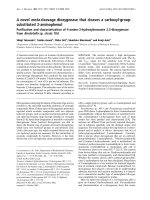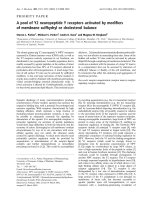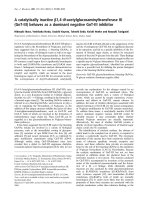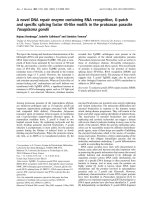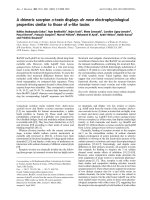Báo cáo y học: " A brave new synthetic world" pdf
Bạn đang xem bản rút gọn của tài liệu. Xem và tải ngay bản đầy đủ của tài liệu tại đây (49.48 KB, 3 trang )
Genome
BBiioollooggyy
2009,
1100::
302
Meeting report
AA bbrraavvee nneeww ssyynntthheettiicc wwoorrlldd
Farren J Isaacs* and Lingchong You
†
Addresses: *Department of Genetics, Harvard Medical School, 77 Avenue Louis Pasteur, Boston, MA 02115, USA.
†
Department of Biomedical
Engineering and Institute for Genome Sciences and Policy, Duke University, 101 Science Drive, Durham, NC 27708, USA.
Correspondence: Farren J Issacs. Email: ; Lingchong You. Email:
Published: 3 February 2009
Genome
BBiioollooggyy
2009,
1100::
302 (doi:10.1186/gb-2009-10-2-302)
The electronic version of this article is the complete one and can be
found online at />© 2009 BioMed Central Ltd
A report of the first meeting on ‘Frontiers in Synthetic
Biology’, Boston, USA, 1-2 December 2008.
Like Aldous Huxley’s Brave New World at the time of its
publication, the field of synthetic biology currently has
skeptics and critics among both scientists and non-scientists.
But in contrast to Huxley’s pessimistic outlook, synthetic
biology has the opportunity to highlight the good to society
that can be derived from biotechnological breakthroughs.
This naturally begs the question: what exactly is synthetic
biology? A meeting at Harvard Medical School last December
revisited this frequently posed question. Keynote speaker
Clyde Hutchison (J Craig Venter Institute, Rockville, USA)
offered his perspective: “while some have a strong desire to
sort this out, I’m not interested in this question, as it is
largely about semantics and not in itself a scientific question”.
Nevertheless, an analogy to computer science provides a
good basis to describe synthetic biology. If we think of the
cell as a computer, the work of synthetic biologists can be
simplified into three main approaches: the creation of a
minimal computer from basic building blocks; software to
program a working computer; and the application of these
devices or knowledge gained in the engineering process. We
describe here a few of the highlights of the meeting.
Presentations covered a wide spectrum of topics, ranging
from the engineering of artificial cells and the creation of gene
circuits in cell-free, prokaryotic and mammalian systems to
the direct synthesis and recoding of whole genomes.
PPrroottoocceellllss aanndd cceellll ffrreeee ssyysstteemmss
In his keynote address, Jack Szostak (Harvard Medical
School, Boston, USA) discussed his group’s efforts to create
lipid-vesicle-based protocells using basic chemical sub-
strates as building blocks. When starting from scratch, many
cellular processes perceived as simple become formidable
challenges. For example, a cell not only has to produce a cell
wall and replicate intracellular biomolecules (nucleic acids,
proteins, lipids), but these processes need to occur in a
coordinated manner to produce growth. Szostak gave an
interesting example of one problem. Large vesicles were
forced through pores of a smaller diameter to try and divide
them. This simple strategy worked, but each round of
division resulted in significant loss of intravesicular
materials: a large sphere holds approximately 40% more
material than two smaller, equal-sized spheres with the
same total surface area as the large sphere. In this context,
Giovanni Murtas (Enrico Fermi Center, Rome, Italy) des-
cribed his group’s efforts to achieve coupling between vesicle
growth and synthesis of intracellular materials. They have
encapsulated enzymatic reactions for synthesizing vesicle
materials within a liposome vesicle.
Given the multitude of technical challenges, the functionality
of such ‘protocells’ remains limited. Researchers in this area
predict that the engineering of protocells could eventually
lead to insights that will explain the emergence of life billions
of years ago. But protocells are more likely to find a use
sooner as nano-scale reactors for producing molecules that
are difficult to produce in cells, such as cytotoxic proteins.
CCoommppoonneennttss,, cciirrccuuiittss aanndd cceellll ppooppuullaattiioonnss
The dominant flavor of synthetic biology is arguably the
integration of non-natural, or synthetic, gene networks into
existing cellular pathways to better understand or program
cellular behavior. These approaches are analogous to the
design and implementation of software that programs
customized functions in a working computer, with the
distinction that engineering of biological systems is per-
formed in the dynamic context of evolution. Yet, despite the
physical access to cellular machinery, programming complex
behavior inside cells remains a challenge.
Addressing such a challenge requires not only the develop-
ment of well-characterized parts (as advocated by the
BioBricks Foundation []), but
also a better understanding of different control strategies.
Addressing the latter point, James Collins (Boston Univer-
sity, USA) described a series of synthetic gene circuits of
diverse function, such as the toggle switch and RNA-based
switches, and the integration of simple circuits to generate
more complex systems. He described the introduction of one
RNA-based switch to give tight control of the expression of a
toxin (CcdB) in the bacterium Escherichia coli. This enabled
precise mapping of the death pathway initiated by the toxin
and revealed a common death pathway in E. coli exposed to
bactericidal agents. Timothy Lu (Harvard-MIT Health
Sciences and Technology, Cambridge, USA), from the same
group, described the practical application of two re-engineered
T7 phages: one encodes a protein that disrupts bacterial
biofilm formation and the other encodes a protein that targets
an antibiotic resistance mechanism in E. coli, improving the
efficacy of antibiotics against the bacteria it infects.
For eukaryotes, Pamela Silver (Harvard Medical School,
Boston, USA) described a number of artificial gene-control
circuits she and her colleagues have devised to carry out
predefined functions in eukaryotic cells. One is a eukaryote-
specific negative feedback oscillator based on intron-mediated
time delay. Transcription of the intron introduces a time
delay, enabling the generation of oscillations by the repressor.
Interestingly, Silver and colleagues observed that the
oscillation characteristics could be modulated by using introns
of varying length. She suggested that such intron-mediated
oscillations might underlie cell-fate decisions in development.
Beyond single cells, increasing effort is being devoted to
programming population dynamics. One of us (LY)
described the use of bacterial communication (quorum
sensing) to program interactions between two populations of
E. coli, which resulted in a synthetic predator-prey eco-
system that can generate oscillations in the two populations.
This synthetic ecosystem has been used to explore the
interplay of cellular motility, population segregation and
signal diffusion in the maintenance of biodiversity in
microbial ecosystems. In addition to temporal dynamics,
cell-cell communication can also be used to generate self-
organized spatial patterns, and two such examples were
presented at the conference. Jian-dong Huang (University of
Hong Kong, Hong Kong) described a system where cell-cell
communication in E. coli was coupled with cellular motility.
The modified bacteria generated a near-perfect, self-
organized ring pattern on an agar plate. Ron Weiss
(Princeton University, Princeton, USA) described another
circuit in E. coli designed to generate a Turing pattern (for
example, hexagonal arrays of spots) in a lawn of bacteria.
These cells synthesize two signals, one serving as an activator
and the second as an inhibitor. Under appropriate conditions,
the system was able to generate regular spot-like patterns.
In addition to exploring the limits of programming complex
dynamics, Weiss proposed that these systems could offer
insight into the dynamics of natural systems, such as
whether self-organization underlies developmental processes
or pigmentation patterns in animal skin.
EEmmeerrggiinngg tteecchhnnoollooggiieess aanndd ggeennoommee eennggiinneeeerriinngg
Traditional genetic engineering technologies devised 20 or
more years ago are now insufficient for the complex
engineering of biological systems required by synthetic
biology. Streamlining of DNA synthesis and the development
of strategies for efficiently introducing synthetic DNA in vivo
were discussed by a number of speakers.
Peter Carr (Massachusetts Institute of Technology, Cambridge,
USA) described work with the goal of automating the entire
DNA synthesis process. He is working towards a pipeline
that can integrate oligonucleotide assembly for any desired
DNA sequence from high-density microchips on microfluidic
devices with optimized DNA error-correction strategies,
yielding the required DNA fragment rapidly and at signi-
ficantly reduced cost. With a similar goal, Heinz Schwer
(Sloning Biotechnology, Puchheim, Germany) presented a
new method of making DNA sequences for use in protein
engineering. Using a library of pre-made double-stranded
DNA triplets that act as universal building blocks, Schwer
and his colleagues are able to assemble any desired DNA
fragment with high fidelity compared to existing DNA
synthesis and cloning methods.
Clyde Hutchison described the Venter Institute’s “quest for a
minimal cell”. With the goal of identifying the minimal set of
genes that are needed for life, this work pursues two main
tracks of research that Hutchison termed synthetic
genomics. First, the group obtained 101 fragments of around
5 kb each from commercial suppliers of synthetic DNA and
assembled the entire genome of Mycoplasma genitalium
through a series of in vitro, bacteria- and yeast-based
strategies. Concurrently, they developed a strategy for
replacing the genome of a bacterial cell with one from another
species, inserting a genome isolated from M. mycoides into
M. capricolum cells. Hutchison described the merging of
these two efforts by transplanting the synthesized M. genita-
lium genome into native M. genitalium strains as
challenging work in progress.
In complementary research, one of us (FI) described work
on genome engineering in E. coli aimed at introducing
increased genetic diversity into cell populations using a
combination of bioengineering and evolution. Our group has
developed a highly efficient recombination method that
gives large numbers of desired mutations across whole
genomes. In one experiment, a new genetic code in E. coli is
being constructed to facilitate the incorporation of non-
natural amino acids and to create safe genetically modified
/>Genome
BBiioollooggyy
2009, Volume 10, Issue 2, Article 302 Isaacs and You 302.2
Genome
BBiioollooggyy
2009,
1100::
302
organisms. The same approach is being applied to obtain
genetic diversity for applications in metabolic pathway engi-
neering. On the theme of creating strains with many
mutations, Fritz Roth (Harvard Medical School, Boston,
USA) described a new high-throughput approach for
creating yeast strains with increased combinations of gene
knockouts or insertions. This strategy may facilitate introduc-
tion of complex genetic circuits into the yeast chromosome.
While a clear and concise definition has yet to emerge,
synthetic biology may simply be part of the natural
maturation of biotechnology, in which the engineering of
biological systems is becoming a formal discipline. Great
expectations exist for biotechnology’s potential in addressing
global challenges in medicine, energy supply and the
environment. Can synthetic biology meet these challenges
and be embraced by its present skeptics and critics? With
hindsight, Huxley’s book shows that anticipating how
developments will change society is probably unreliable;
only time will tell if synthetic biology can channel bio-
technology advances to the greater good of society.
/>Genome
BBiioollooggyy
2009, Volume 10, Issue 2, Article 302 Isaacs and You 302.3
Genome
BBiioollooggyy
2009,
1100::
302
